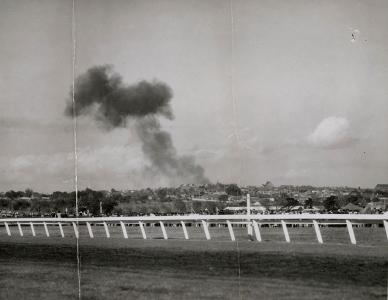2021 marks the centenary of the Royal Australian Air Force (RAAF). The National Archives’ collection contains many stories of service and sacrifice from the RAAF’s first 100 years.
One event – the North Melbourne air crash of 1943 – occurred just a few hundred metres from where the National Archives' Victoria office is now located.
On 4 September 1943, over 60,000 war-weary Melburnians gathered at Flemington Racecourse for a morale-building civil defence day. The highlight was going to be a 30-minute aerial display by the RAAF with simulated strafing, dive bombing, dog fighting and a parachute drop.
But instead of a thrilling display of military manoeuvres, the crowd ended up witnessing the tragedy of war first hand.
The accident
Two Vultee Vengeance aircraft stationed at RAAF Laverton were detailed for the simulated dive bombing.
One of them was piloted by 26-year-old Flight Lieutenant Richard Henry Roe of Benalla, Victoria. Roe was an above average pilot with nearly 800 hours flying experience, including combat experience in Europe and New Guinea. Flying in the air gunner seat was 25-year-old Pilot Officer James Noel Harris of Clifton Hill, Melbourne.
The two Vengeance aircraft arrived over Flemington escorted by a pair of Spitfires. With the sun at their backs, it would have been a spectacular sight.
Roe executed the first dive bombing run, pulling up at about 800 feet as explosives on the ground detonated to simulate the blast. After climbing to over 5000 feet, Roe began his second dive at an estimated speed of 500 km/h.
About 600 feet from the ground, Roe pulled up and began to gain altitude. But he deviated from the authorised flight plan by performing what looked like a ‘victory roll’. Part way through the roll, the plane began to dive again. Flying in an inverted position, it headed east at high speed towards North Melbourne and disappeared out of sight.
Losing altitude, the upside-down plane barely cleared a train at Macaulay railway station, flying so low that a woman cycling near the station fell off her bike as it passed.
The plane slammed into the roof of a wheat warehouse in Macaulay Road. Roe and Harris were killed instantly as the plane ripped through the warehouse, crashing through two brick walls before exploding. The blaze took two and a half hours to extinguish.
Fortunately, no one was inside the warehouse at the time, and two cats kept there to control mice managed to survive.
The inquiry
The disaster and its aftermath are vividly captured in photographs submitted to both a RAAF Court of Inquiry investigation and a Victorian coronial inquest.
As the plane was totally destroyed, the RAAF investigation could not conclusively determine the cause of the accident. However, the most likely cause was the quick release buckles on Roe’s harness, which may have come undone as the plane rolled, causing him to slip away from the controls. The inquiry recommended that Vengeance aircraft not be used in aerobatics until the buckles were modified.
The Court of Inquiry also recommended greater planning and practice for air displays so that commanding officers could ‘check any tendency shown by pilots to depart … from the instructions given, through a mistaken intention of making the display as spectacular as possible’.
The legacy
Richard Roe and James Harris were buried near each other in Springvale War Cemetery. Harris was survived by his wife and young child.
As for Roe, the Benalla Ensign mourned the loss of ‘Benalla’s Greatest Airman’ on its front page. Roe was also posthumously awarded the Distinguished Flying Cross (DFC) for his courageous combat flying in New Guinea in 1942 and early 1943.
A memorial plaque on Macaulay Road in North Melbourne now marks the site of the air crash.
Richard Roe and James Harris’s service records are just two of more than a million World War II service records in the National Archives’ collection. We’re digitising these records over the next few years to make them easily available to all Australians.









